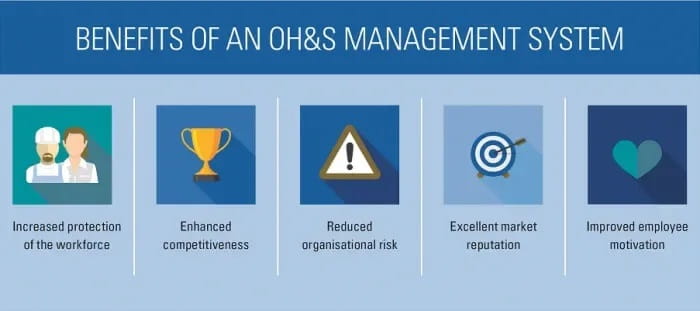Occupational Health and Safety (OHS) has evolved significantly over the years, driven by an increasing focus on employee well-being, regulatory standards, and the understanding that a safe workplace is a productive one. As workplaces worldwide adapt to new challenges, businesses need to rethink their Occupational Health and Safety Management Systems (OHSMS) to align with global trends and evolving regulations. This article explores the key trends shaping OHS today and offers insights on how to update your OHSMS to keep pace with these changes.
Trend 1: Increased Focus on Mental Health and Well-being
One of the most prominent shifts in OHS is the heightened awareness of mental health and well-being. While traditional OHS systems focus on physical safety, modern workplaces are increasingly recognizing that mental health is just as crucial to employee productivity and overall workplace safety.
How Your OHSMS Should Evolve
Integrate mental health protocols within your OHSMS by including resources for employee assistance programs (EAPs), stress management training, and regular mental health assessments. Consider training managers and supervisors to recognize signs of mental health issues, fostering an environment where employees feel comfortable discussing well-being concerns. Clear policies and resources that prioritise mental health within the OHSMS not only align with global best practices but also create a supportive work culture that can reduce burnout and improve productivity.
Trend 2: Adapting to Remote and Hybrid Work Environments
The rise of remote and hybrid work has reshaped traditional notions of workplace safety. With employees now working from various locations, companies face new challenges in managing health and safety beyond the physical office space. Remote work environments introduce unique ergonomic and mental health risks that need to be addressed.
How Your OHSMS Should Evolve
Update your OHSMS to include safety protocols for home offices, including guidance on ergonomic setups, equipment requirements, and recommended breaks to reduce strain. You may also want to provide online resources or training to educate remote employees on proper workplace setups and routines to maintain well-being. Additionally, adapt your incident reporting systems to accommodate remote workers, ensuring they have a clear channel to report any health and safety concerns they may encounter outside the office.
Trend 3: Emphasis on Data-Driven Safety Insights
Advancements in technology, such as wearable devices and IoT sensors, have made it possible to gather real-time data on workplace safety conditions. This data provides valuable insights into accident prevention, safety compliance, and the overall health of a workforce, enabling companies to make proactive adjustments to their OHS practices.
How Your OHSMS Should Evolve
Consider integrating data analytics tools into your OHSMS to monitor safety trends and identify areas of concern before they become issues. For example, IoT-enabled wearables can monitor fatigue, movement, and exposure to harmful substances in real time. Analysing this data can help you develop more targeted safety measures, reduce workplace injuries, and create an OHSMS that is both reactive and preventative.
Trend 4: Addressing the Aging Workforce
With an increasing number of older employees remaining in the workforce, OHS programs need to be inclusive of age-related health and safety needs. Older employees may face unique risks related to physical demands and slower recovery times from injuries, which can affect productivity and safety if not managed properly.
How Your OHSMS Should Evolve
Adapt your OHSMS to be inclusive of age-related accommodations, such as ergonomic adjustments, regular health screenings, and flexible work options. Make sure your training materials are accessible and tailored to diverse age groups to ensure all employees understand safety protocols. Additionally, consider implementing mentorship programs where younger employees can learn safe work practices from more experienced colleagues, fostering a culture of safety across generations.
Trend 5: Embracing Global Standards and ISO 45001
As global markets become increasingly interconnected, standardising safety practices across borders has become essential. ISO 45001, the international standard for Occupational Health and Safety Management, provides a globally recognized framework for managing workplace safety and is rapidly becoming a preferred standard for companies with global footprints.
How Your OHSMS Should Evolve
Align your OHSMS with ISO 45001 to ensure it meets international standards. This involves a risk-based approach to identifying hazards, setting measurable safety objectives, and maintaining an ongoing commitment to improving OHS practices. Implementing ISO 45001 also improves your organisation’s credibility, as clients and partners can trust that you meet globally accepted safety standards. If you’re already certified, consider conducting regular reviews to ensure compliance with any updates to ISO 45001 and evolving safety regulations.
Trend 6: Integrating Environmental Health with OHS
Sustainability is no longer just an environmental concern; it’s becoming intertwined with health and safety as organisations look to minimise their ecological footprint. By integrating environmental health considerations into OHSMS, companies can ensure a safer and more responsible workplace for employees.
How Your OHSMS Should Evolve
Merge environmental health policies with your OHSMS, focusing on reducing exposure to environmental hazards such as air pollution, chemical spills, and noise pollution. Educate employees on sustainable practices and their impact on personal and workplace health, encouraging environmentally safe behaviour. Additionally, aim to reduce waste, energy use, and exposure to toxic substances in your operations, making your OHSMS a comprehensive framework for workplace health, safety, and environmental responsibility.
Trend 7: Building a Safety-First Culture Through Leadership Engagement
Safety culture is paramount in today’s workplaces, with a noticeable trend toward involving leadership at all levels to reinforce the importance of OHS. Engaged leaders set the tone for the organisation, ensuring that health and safety are prioritised and actively maintained.
How Your OHSMS Should Evolve
Encourage your leadership team to take an active role in promoting safety practices, setting examples, and maintaining open lines of communication around safety issues. Include safety leadership training in your OHSMS to equip managers with the skills needed to model safety-first behaviour and effectively address safety concerns. Leadership commitment to safety strengthens trust and builds a culture where every employee feels responsible for maintaining a safe workplace.
Staying ahead of these trends not only strengthens your compliance but also enhances your organisation’s reputation and resilience in a fast-changing world. Now is the time to assess and update your OHSMS, taking advantage of these global trends to create a safer, more forward-thinking workplace.




